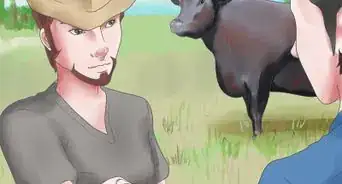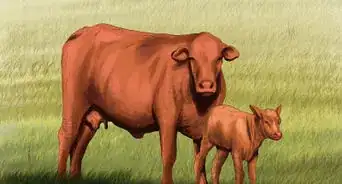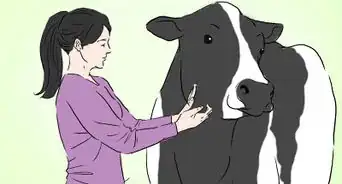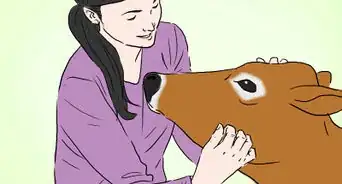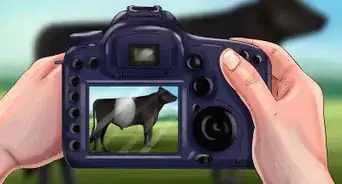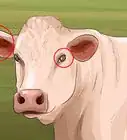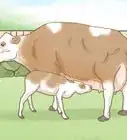X
This article was co-authored by Karin Lindquist. Karin Lindquist earned a BSc in Agriculture as an Animal Science major from the University of Alberta, Canada. She has over 20 years of experience working with cattle and crops. She's worked for a mixed-practice veterinarian, as a sales representative in a farm supply store, and as a research assistant doing rangeland, soil, and crop research. She currently works as a forage and beef agriculture extension specialist, advising farmers on a variety of issues relating to their cattle and the forages they grow and harvest.
This article has been viewed 148,371 times.
Steps
-
1Do a search on the Internet or a Cattle Breeds book on "Angus" or "Black Angus" cattle.[1]
-
2Study the characteristics of the breed. Note the following:[2]
-
Coloration: Angus cattle are all black. Angus associations allow some white to be present just behind the navel under the belly, but all animals that are registered as Angus cattle should be all black, from nose to tail.
- Because there are around six other breeds that also have black cattle, this can lead to someone who has no experience with cattle or the breeds of this domestic bovine to have great confusion as to what really are Angus cattle and what aren't, not to mention why so many breeds have black cattle instead of following their traditional coloration and characteristics. The reason is this: Since the USDA (United States Department of Agriculture) gave the go-ahead for the American Angus Association (AAA) to start a more aggressive campaign to market their beef, the only breed that could make the cut for this marketing campaign was Angus. CAB (Certified Angus Beef) is that marketing scheme that the AAA thought up of to market their cattle through. However, as far as the USDA was concerned, CAB had specifications that were for cattle that were black, no matter if they had a spec of Angus blood in them or not. It was this specification that allowed other breeds to try to infuse Angus genetics in their stock to create "purebred" (as in Charolais) or full-blood cattle that where black. Thus, we now see the breeds mentioned above having black cattle in them to meet these specifications and get a premium for these animals. The AAA also has a program called Angus Source® that allows Angus-sired calves, no matter what other breed[s] they are comprised of, to be eligible for a premium at the auction market and also be qualified to have their meat be sold as Certified Angus Beef.
- Body type and characteristics: Angus cattle are blocky cattle (which is typical of every beef breed), but are not nearly as muscular as Charolais, Gelbvieh, Simmentals nor Limousins. Bulls should have a muscular crest over their necks, whereas cows should lack this and have an overall feminine look. Most Angus cattle are not big animals. Historically, Angus cows weighed only around 950 to 1200 lbs, and bulls weighed around 1800 to 2300 lbs. Today, you may find a fair number of herds with cows that may reach over 2000 lbs, and bulls weighing over 4000 lbs, however, there are still other herds that have retained the smaller size.
- Head characteristics: Angus cattle have what cattle producers call "Angus-looking" heads. All Angus are polled cattle; you will never find a purebred Angus with horns. The "Angus look" means that Angus typically have perky-looking ears, a wide forehead with a more narrow and finer muzzle. They have comparably wide lips like the Hereford, but they're a little more finer and more trimmed than Herefords, with slightly smaller noses. Some may say that the head of an Angus looks a little more finer than other breeds like Charolais or Hereford, mostly because the head appears smaller in comparison with the rest of the body. However it is slightly wider across the forehead than a Shorthorn's, though, in bulls, forehead width between Shorthorns and Angus are quite similar. It is more noticeable between Shorthorn and Angus cows, though. The head also appears shorter in length than other breeds like Holstein, Charolais or Limousin.
- Other characteristics: Angus cattle originate from Aberdeen, Scotland, where the climate there is not all that friendly to many breeds of cattle. Angus are typically hardy, adaptable, generally good natured (though most often less so than Herefords, Highlanders or Shorthorns), and resistant to harsh weather. They mature quite early, and are well-known for their excellent carcass qualities. They have great calving ease qualities, great forage convertibility, good mothering ability, good milking ability, and great ability to do well on their own with minimal management, making them an ideal animal to raise in ranch-like conditions. Their thin skin and black hide, however, make them less-than-ideal to raise in tropical climates because they are able to absorb heat too easily and thus suffer from heat stroke and exhaustion. Angus are, however, great animals to raise in climates with moderate summers and cold, snowy winters.
Advertisement -
Coloration: Angus cattle are all black. Angus associations allow some white to be present just behind the navel under the belly, but all animals that are registered as Angus cattle should be all black, from nose to tail.
-
3Go on a field trip or road trip and see if you can find farms and ranches with Angus cattle. Take pictures of what you thought were Angus cattle, and compare them with pictures of Angus cattle on the Internet and in your Cattle breeds book.
Advertisement
Community Q&A
-
QuestionI purchased a bull that has a white spot underneath. Do pure Black Angus bulls ever have any white on them?
 KarinTop AnswererYes, some of the purebred Angus bulls will have white, but they won't be true full-bloods like the original Aberdeen or Scottish lines that are pure black. According to the American Angus Association, any animal that has white on or before the navel (closer to the chest) cannot be registered.
KarinTop AnswererYes, some of the purebred Angus bulls will have white, but they won't be true full-bloods like the original Aberdeen or Scottish lines that are pure black. According to the American Angus Association, any animal that has white on or before the navel (closer to the chest) cannot be registered. -
QuestionDo Angus have short legs?
 KarinTop AnswererSome do, some don't, it just depends on how they're selected and what genetic lines they come from. Some cows with their breeding can look like "gutless wonders" with seemingly longer legs, and other cows are massive barrels with a huge rumen that make them look like they have short legs.
KarinTop AnswererSome do, some don't, it just depends on how they're selected and what genetic lines they come from. Some cows with their breeding can look like "gutless wonders" with seemingly longer legs, and other cows are massive barrels with a huge rumen that make them look like they have short legs. -
QuestionDo Angus cattle have blue tongues?
 Community AnswerAngus cattle have black or grey tongues that are pink underneath. They might appear blue or a smoky-blue in different lighting conditions.
Community AnswerAngus cattle have black or grey tongues that are pink underneath. They might appear blue or a smoky-blue in different lighting conditions.
Advertisement
Warnings
- Just because they don't have horns, doesn't mean it makes them less dangerous to be around.[5]⧼thumbs_response⧽
- Not all Angus cattle are friendly, and you may find that they may take flight for the other end of the pasture if they see you walking beside the fence. If there's a bull around, or a cow is protecting her calf, be very cautious as both can get quite protective and even aggressive towards you.⧼thumbs_response⧽
Advertisement
References
- ↑ http://afs.okstate.edu/breeds/cattle/
- ↑ http://afs.okstate.edu/breeds/cattle/angus/index-2.html
- ↑ https://www.farmanddairy.com/top-stories/how-to-identify-common-breeds-of-beef-cattle/424963.html
- ↑ https://www.farmanddairy.com/top-stories/how-to-identify-common-breeds-of-beef-cattle/424963.html
- ↑ http://theconversation.com/when-cows-attack-how-dangerous-are-cattle-and-how-can-you-stay-safe-around-them-79524
About This Article
Advertisement
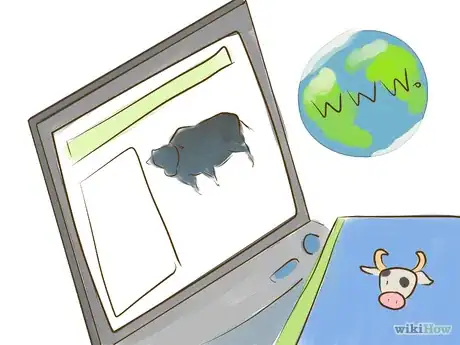

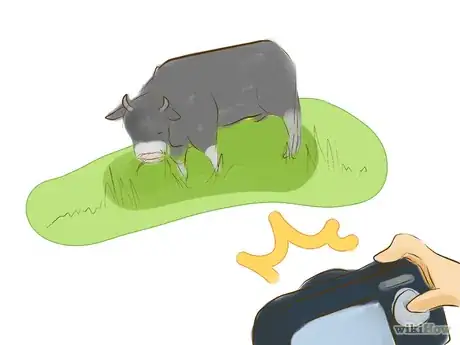
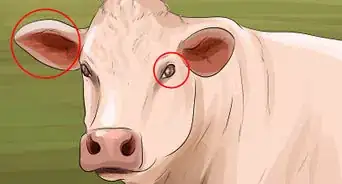
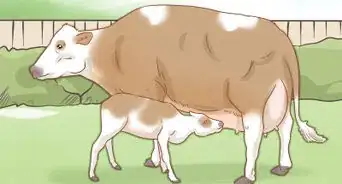


-in-Cattle-Step-6.webp)
